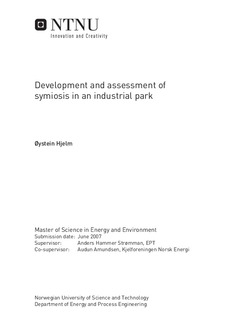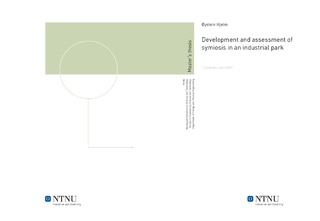| dc.description.abstract | As weather records are broken, and the topic of global warming and climate change, focus has been set on how this current development could be slowed or stopped. A change in paradigm must be conducted in order to address sustainable development. This paper has focused on how the field of industrial ecology and the tool of eco-industrial parks could be used to improve environmental performance of industrial systems. To evaluate the methods an industrial area at Moss has been further developed and new processes have been introduced. The system consists of an oxy-fuel CHP with carbon dioxide capture using the landfill gas as fuel, a urea plant, an ammonia plant to deliver ammonia to the urea plant and a cryogenic air separator plant providing nitrogen to the ammonia plant and pure oxygen to the CHP. Some carbon dioxide not used in the urea plant is used to increase the growth in a greenhouse. To evaluate the system, two simulation tools have been used. HYSYS has been used to simulate the processes involved and to arrange data for flow analysis. The heat exchanges had been assessed using Pro Pi 1, a tool specifically designed to create composite curves. Several simplifications have been made to easy the simulation. The CHP has an electric efficiency of 27 per cent and a total efficiency of 73,8 per cent. The electric exergy efficiency of the CHP is 28 per cent with a total system exergy efficiency of 67,7 per cent. The proposed system emits 35 per cent less carbon dioxide compared with stand alone processes. The system produce more heat then is needed to cover almost every process, and also the total demand in both the low- and high temperature district heating. The only process in need of external heating is the syngas reformer, which operates at such a high level that a stream of 46 kg/h of methane must be added. The output form the park is 8120 tonnes of urea annually, based on 8000 operating hours. The composite curves used to describe the heat exchange in the system proved to be a valuable tool when evaluating the need for utilities in the system. Both the material and energy flow analysis provided a good way to present energy and resource flows in the system. However, the exergy flow analysis proved to lack well developed tools to include irreversibility connected to the flows. Based on the guidelines presented from the Kalundborg EIP, the designed system could be called an eco-industrial park. However, economic analysis must be conducted to explore if there are economic incentives for the companies to develop such a park. Based on the experiences in this paper, further research should be made to develop better tools to calculate exergy losses based on HYSYS simulations. Also, an assessment of the economics connected to the system should be conducted. | nb_NO |

